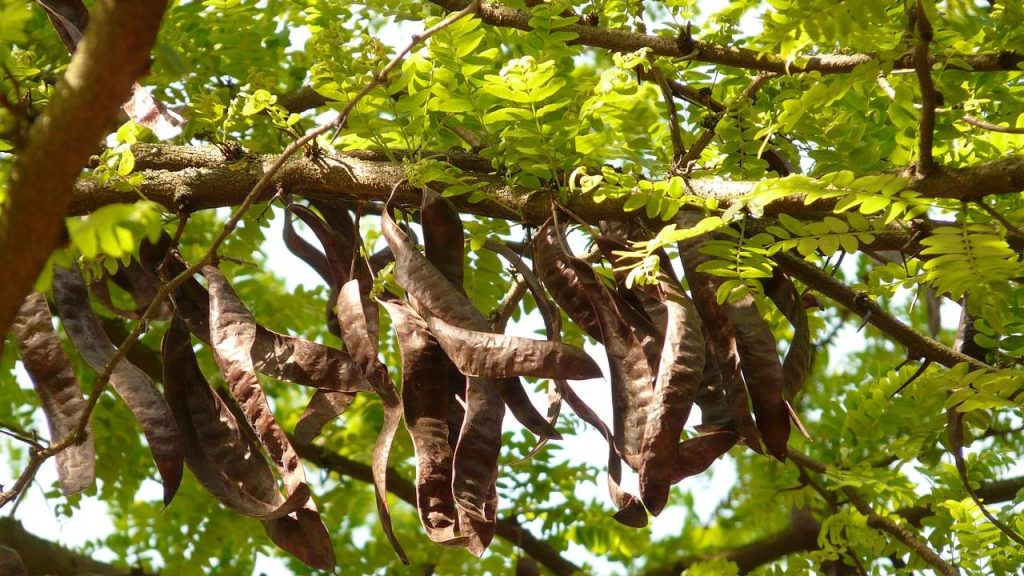Carob gum is a natural and versatile food additive. It is ideal for making gluten-free and vegan products.

- What is carob or locust bean gum?
- Locust bean: what it is used for
- Carob gum: health effects
- Sustainability of carob gum
Carob gum or locust bean is obtained from the seeds of the carob tree, the fruit of the carob tree, a very common tree in the Mediterranean region, in America and in Australia. The largest growing areas are in the Spanish regions of Valencia and Catalonia. Do you know what it is used for and what its health effects are?
WHAT IS CAROB OR LOCUST BEAN GUM?
To obtain the carob gum, the seeds are subjected to an acid treatment that eliminates the skin. Then the seeds are split so that by means of a sieve the endosperm, which is hard, can be separated. This endosperm is ground with rollers to get the locust bean powder.
This whitish powder is chemically a galactomannan, that is, a polysaccharide composed of the monosaccharide’s galactose and mannose. It is dietically a soluble fiber.
Carob gum is not the same as carob flour. This is obtained by grinding the carob pods without the seeds, after they have been dehydrated. This carob flour has a slightly sweet taste and very similar to cocoa so it is used to make alternative dietary products to chocolate, low in fat and rich in fiber, calcium and other minerals and antioxidant compounds.
LOCUST BEAN: WHAT IT IS USED FOR
The locust bean, when in contact with liquids, becomes a colloid and a gel if a little sodium borate is added. Its physical properties make it a binder and thickening additive widely used by the food and cosmetic industries. In ingredient lists it is often identified with the code E410.
- Even a small amount of carob gum gives liquids a gelatinous texture and thickens them.
- As the volume of the mixtures increases, it is often used in gluten-free alternative products.
- Flour is insensitive to heat, acid and salt and can therefore be used in a variety of ways.
- It also ensures that the mixtures are homogeneous.
You’ll find carob gum in the ingredient lists of the following products, among others:
- Jams and preserves.
- Jellies, puddings and mousses.
- Drinks based on vegetable milks.
- Ice cream.
- Canned fruits or vegetables.
- Empanadas and other similar products.
- Baked goods (especially gluten-free products).
- Food for diabetics.
- You can find carob gum in all organic supermarkets or health food stores. It is also available through online stores.
o CAROB GUM: HEALTH EFFECTS
- Carob gum is generally well tolerated. As a soluble fiber, in theory, it helps reduce bad LDL cholesterol and contributes to the good condition of the intestinal microbiota (it is a prebiotic). In addition, it contains small proportions of protein and calcium. However, it is used in such small amounts that little beneficial effect can be expected compared to whole foods rich in soluble fiber.
- It is approved as a food additive without restrictions, it can even be used in baby food and in products with organic certification.
- Used for infant reflux
- Carob gum is used as an additive in infant formulas for babies experiencing reflux, which is characterized by frequent episodes of vomiting.
- It helps thicken the formula and prevents it from re-climbing into the esophagus after entering the stomach. It also slows the rate at which food moves from the stomach to the intestines. This can also reduce bowel problems and reflux in babies.
- As with all foods and products that are ingested, allergic reaction is always possible. People with a soy allergy should be especially careful because a cross-reaction is possible.
SUSTAINABILITY OF CAROB GUM
The tree is ideal for sustainable organic farming. Its cultivation even has ecological value, because it thrives even in poor, dry and nutrient-devoid soils. Like olive trees, carob trees are ideal for reforesting semi-desert landscapes.
Tree roots protect dry areas from erosion and oxygenate the soil. In warm-growing regions, its canopy provides protection from the sun and wind and provides important habitat for birds, insects and other wildlife.
Collecting the mature carob pods is quite time-consuming and expensive, as it is done by hand and cannot be automated. The cultivation of carob does not require any pesticides. On the other hand, carob wood is durable and resistant, suitable for fences or furniture, among other uses.



